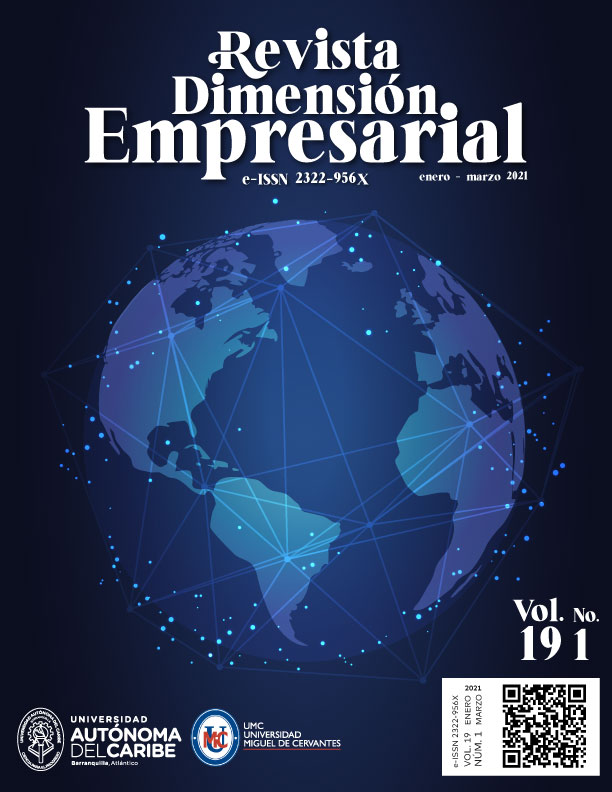Impact of Absorptive Capacity and Ambidexterity on Innovation
DOI:
https://doi.org/10.15665/dem.v19i1.2616Palabras clave:
capacidad de absorción, ambidiestralidad, innovación tecnológica, manufacturaResumen
This study attempts to design an approach showing how absorptive capacity and ambidexterity are related to technological innovation in Peruvian manufacturing firms. A structural equation model is proposed. The sample is made up of 783 manufacturing firms. It was found that although Peruvian manufacturing firms invest little money in research and development, they are capable of developing dynamic capabilities, such as absorptive capacity and ambidexterity in order to better carry out technological innovation.
Citas
Aguilera, R. V., Ciravegna, L., Cuervo-Cazurra, A., & Gonzalez-Perez, M. A. (2017). Multilatinas and the internationalization of Latin American firms. Journal of World Business, 52(4), 447-460. DOI: https://doi.org/10.1016/j.jwb.2017.05.006
Aljanabi, A. R. A., & Mohd Noor, N. A. (2015). The mediating role of market orientation on entrepreneurial orientation, absorptive capacity and technological innovation capabilities. Asian Social Science, 11(5), 219-234. DOI: https://doi.org/10.5539/ass.v11n5p219
Aryasa, K. B., Wahyuni, S., Sudhartio, L., & Wyanto, S. H. (2017). The impact of absorptive capacity, organizational inertia on alliance ambidexterity and innovation for sustained performance. Academy of Strategic Management Journal, 16(3), 1-19.
Byrne, B. M. (2010). Structural equation modeling with AMOS: Basic concepts, applications, and programming (2nd. ed.). Routledge. DOI: https://doi.org/10.4324/9781410600219
Cabeza-Pullés, D., Fernández-Pérez, V., & Roldán-Bravo, M. I. (2020). Internal networking and innovation ambidexterity: The mediating role of knowledge management processes in university research. European Management Journal, 38(3), 450-461. DOI: https://doi.org/10.1016/j.emj.2019.12.008
Camisón, C., & Villar-López, A. (2014). Organizational innovation as an enabler of technological innovation capabilities and firm performance. Journal of Business Research, 67(1), 2891-2902. DOI: https://doi.org/10.1016/j.jbusres.2012.06.004
Chang, Y., Hughes, M., & Hotho, S. (2011). Internal and external antecedents of SMEs’ innovation ambidexterity outcomes, Management Decision, 49(10), 1658-1676. https://doi.org/10.1108/00251741111183816
Cao, Q., Gedajlovic, E., & Zhang, H. (2009). Unpacking organizational ambidexterity: Dimensions, contingencies, and synergistic effects. Organization Science, 20(4), 781-796. DOI: https://doi.org/10.1287/orsc.1090.0426
Cohen, W. M., & Levinthal, D. A. (1990). Absorptive capacity: A new perspective on learning and innovation. Administrative Science Quarterly, 35(1), 128-152. DOI: https://doi.org/10.2307/2393553
Del Carpio-Gallegos, J. F., & Miralles-Torner, F. (2018). Absorptive capacity and innovation in low-tech companies in emerging economies. Journal of Technology Management & Innovation, 13(2), 3-11. DOI: https://doi.org/10.4067/s0718-27242018000200003
Derbyshire, J. (2014). The impact of ambidexterity on enterprise performance: Evidence from 15 countries and 14 sectors. Technovation, 34(10), 574-581. DOI: https://doi.org/10.1016/j.technovation.2014.05.010
Diaz-Molina, I. (2018). The role of strategic and operational absorptive capacity in organizational ambidexterity [Conference session]. 2018 Engaged Management Scholarship Conference, Temple University, Philadelphia, PA, United States. DOI: https://doi.org/10.2139/ssrn.3235526
Dutta, S. K. (2013). Market orientation ambidexterity. SCMS Journal of Indian Management, 10(1), 54.
Escribano, A., Fosfuri, A., & Tribó, J. A. (2009). Managing external knowledge flows: The moderating role of absorptive capacity. Research Policy, 38(1), 96-105. DOI: https://doi.org/10.1016/j.respol.2008.10.022
Fernandez, V. (2017). The finance of innovation in Latin America. International Review of Financial Analysis, 53, 37-47. DOI: https://doi.org/10.1016/j.irfa.2017.08.008
Fornell, C., & Larcker, D. F. (1981). Evaluating structural equation models with unobservable variables and measurement error. Journal of Marketing Research, 18(1), 39–50. DOI: https://doi.org/10.2307/3151312
Gibson, C. B., & Birkinshaw, J. (2004). The antecedents, consequences, and mediating role of organizational ambidexterity. Academy of Management Journal, 47(2), 209-226. DOI: https://doi.org/10.5465/20159573
Gregson, G. (2020). Innovation systems and entrepreneurial ecosystems: Implications for policy and practice in Latin America. Academy of Management Global Proceedings, 301. DOI: https://doi.org/10.1177/0269094219896096
Gunday, G., Ulusoy, G., Kilic, K., & Alpkan, L. (2011). Effects of innovation types on firm performance. International Journal of production economics, 133(2), 662-676. DOI: https://doi.org/10.1016/j.ijpe.2011.05.014
Hair, J. F., Black, W. C., Babin, B. J., & Anderson, R. E. (2010). Multivariate data analysis (7th ed.). Prentice Hall.
Hair Jr., J. F., Sarstedt, M., Hopkins, L., & Kuppelwieser, V. G. (2014). Partial least squares structural equation modeling (PLS-SEM). European Business Review. 2(6), 106-121. DOI: https://doi.org/10.1108/ebr-10-2013-0128
He, Z. L., & Wong, P. K. (2004). Exploration vs. exploitation: An empirical test of the ambidexterity hypothesis. Organization Science, 15(4), 481-494. DOI: https://doi.org/10.1287/orsc.1040.0078
Ince, H., Imamoglu, S. Z., & Turkcan, H. (2016). The effect of technological innovation capabilities and absorptive capacity on firm innovativeness: A conceptual framework. Procedia-Social and Behavioral Sciences, 235, 764-770. DOI: https://doi.org/10.1016/j.sbspro.2016.11.078
Koçoglu, I., Akgün, A. E., & Keskin, H. (2015). The differential relationship between absorptive capacity and product innovativeness: A theoretically derived framework. International Business Research, 8(7), 108. DOI: https://doi.org/10.5539/ibr.v8n7p108
Laursen, K., & Salter, A. (2006). Open for innovation: The role of openness in explaining innovation performance among U.K. manufacturing firms. Strategic Management Journal, 27, 131–150. doi: 10.1002/smj.507 DOI: https://doi.org/10.1002/smj.507
Lavie, D., Stettner, U., & Tushman, M. L. (2010). Exploration and exploitation within and across organizations. The Academy of Management Annals, 4(1), 109-155. DOI: https://doi.org/10.5465/19416521003691287
Liao, S., Liu, Z., & Zhang, S. (2018). Technology innovation ambidexterity, business model ambidexterity, and firm performance in Chinese high-tech firms. Asian Journal of Technology Innovation, 26(3), 325-345. DOI: https://doi.org/10.1080/19761597.2018.1549954
Limaj, E., Bernroider, E. W., & Choudrie, J. (2016). The impact of social information system governance, utilization, and capabilities on absorptive capacity and innovation: A case of Austrian SMEs. Information & Management, 53(3), 380-397. DOI: https://doi.org/10.1016/j.im.2015.12.003
Lin, H. E., McDonough III, E. F., Lin, S. J., & Lin, C. Y. Y. (2013). Managing the exploitation/exploration paradox: The role of a learning capability and innovation ambidexterity. Journal of Product Innovation Management, 30(2), 262-278. DOI: https://doi.org/10.1111/j.1540-5885.2012.00998.x
Lucena, A., & Roper, S. (2016). Absorptive capacity and ambidexterity in R&D: Linking technology alliance diversity and firm innovation. European Management Review, 13(3), 159-178. DOI: https://doi.org/10.1111/emre.12074
Mardi, M., Arief, M., Furinto, A., & Kumaradjaja, R. (2018). Sustaining organizational performance through organizational ambidexterity by adapting social technology. Journal of the Knowledge Economy, 9(3), 1049-1066. DOI: https://doi.org/10.1007/s13132-016-0385-5
Martinez-Senra, A. I., Quintas, M. A., Sartal, A., & Vázquez, X. H. (2015). How can firms’ basic research turn into product innovation? The role of absorptive capacity and industry appropriability. IEEE Transactions on Engineering Management, 62(2), 205-216. DOI: https://doi.org/10.1109/tem.2014.2386614
Najafi-Tavani, S., Najafi-Tavani, Z., Naudé, P., Oghazi, P., & Zeynaloo, E. (2018). How collaborative innovation networks affect new product performance: Product innovation capability, process innovation capability, and absorptive capacity. Industrial Marketing Management, 73, 193-205.DOI: https://doi.org/10.1016/j.indmarman.2018.02.009
Olavarrieta, S., & Villena, M. G. (2014). Innovation and business research in Latin America: An overview. Journal of Business Research, 67(4), 489-497. DOI: https://doi.org/10.1016/j.jbusres.2013.11.005
O’Reilly III, C. A., & Tushman, M. L. (2008). Ambidexterity as a dynamic capability: Resolving the innovator’s dilemma. Research in Organizational Behavior, 28, 185-206. DOI: https://doi.org/10.2139/ssrn.978493
Pelagio Rodriguez, R., Hechanova, M., & Regina, M. (2014). A study of culture dimensions, organizational ambidexterity, and perceived innovation in teams. Journal of Technology Management & Innovation, 9(3), 21-33. DOI: https://doi.org/10.4067/s0718-27242014000300002
Rammer, C., Czarnitzki, D., & Spielkamp, A. (2009). Innovation success of non-R&D-performers: Substituting technology by management in SMEs. Small Business Economics, 33(1), 35-58. DOI: https://doi.org/10.2139/ssrn.1314246
Revilla, E., Prieto, I. M., & Rodríguez, B. (2011). Information technology and the ambidexterity hypotheses: An analysis in product development. Journal of Operations and Supply Chain Management (JOSCM), 4(2), 1-18. DOI: https://doi.org/10.2139/ssrn.1002973
Schoenmakers, W., & Duysters, G. (2006). Learning in strategic technology alliances. Technology Analysis & Strategic Management, 18(2), 245–264. DOI: https://doi.org/10.1080/09537320600624162
Solís-Molina, M., Hernández-Espallardo, M., & Rodríguez-Orejuela, A. (2018). Performance implications of organizational ambidexterity versus specialization in exploitation or exploration: The role of absorptive capacity. Journal of Business Research, 91, 181-194. DOI: https://doi.org/10.1016/j.jbusres.2018.06.001
Thornhill, S. (2006). Knowledge, innovation and firm performance in high-and low-technology regimes. Journal of Business Venturing, 21(5), 687-703. DOI: https://doi.org/10.1016/j.jbusvent.2005.06.001
Vrontis, D., Thrassou, A., Santoro, G., & Papa, A. (2017). Ambidexterity, external knowledge and performance in knowledge-intensive firms. The Journal of Technology Transfer, 42(2), 374-388. DOI: https://doi.org/10.1007/s10961-016-9502-7
Wang, C. L., & Rafiq, M. (2014). Ambidextrous organizational culture, contextual ambidexterity and new product innovation: A comparative study of UK and Chinese high‐tech firms. British Journal of Management, 25(1), 58-76. DOI: https://doi.org/10.1111/j.1467-8551.2012.00832.x
Wei, Z., Yi, Y., & Guo, H. (2014). Organizational learning ambidexterity, strategic flexibility, and new product development. Journal of Product Innovation Management, 31(4), 832-847. DOI: https://doi.org/10.1111/jpim.12126
Wong, C. W., Wong, C. Y., & Boon-itt, S. (2013). The combined effects of internal and external supply chain integration on product innovation. International Journal of Production Economics, 146(2), 566-574. DOI: https://doi.org/10.1016/j.ijpe.2013.08.004
Zhao, X., Lynch, J. G., Jr., & Chen, Q. (2010). Reconsidering Baron and Kenny: Myths and truths about mediation analysis. Journal of Consumer Research, 37(2), 197-206. doi: 10.1086/651257 DOI: https://doi.org/10.1086/651257
Zou, T., Ertug, G., & George, G. (2018). The capacity to innovate: A meta-analysis of absorptive capacity. Innovation, 20(2), 87-121. DOI: https://doi.org/10.1080/14479338.2018.1428105
Descargas
Publicado
Cómo citar
Número
Sección
Licencia
Derechos de autor 2021 Javier Fernando Del Carpio Gallegos, Francesc Miralles, Eduardo Javier Soria Gomez

Esta obra está bajo una licencia internacional Creative Commons Atribución-NoComercial-SinDerivadas 4.0.
Tenga en cuenta que al presionar el botón "guardar y continuar" que está al final, Usted está asumiendo todos los compromisos éticos y legales que aquí se enuncian. Ellos establecen las responsabilidades de la legislación en materia de derechos de propiedad intelectual. Para esto se asume que quien está efectuando la acción de presentar el escrito obra de buena fe y se representa a sí mismo y a los demás autores del artículo postulado.
En este sentido, los autores conservan todos los derechos de los cuales son titulares y autorizan la reproducción gratuita del documento enviado. En el evento de ser necesario, asumirán, al presionar el botón "guardar y continuar", la responsabilidad legal derivada de los derechos patrimoniales los cuales son gratuitos en razón al no cobro por ningún procedimiento de la Revista.
En consecuencia, El(Los) autor(es) representados por quien adelanta la postulación del artículo a evaluación y eventual publicación,
Declaro(amos):
1. Que soy (somos) el (los) autor(es) del artículo {aquí va el nombre del artículo colocado automáticamente}.
2. Que ésta es una obra original conforme a la ley de propiedad intelectual de derechos de autor colombiana.
3. Que el contenido del artículo de la referencia no ha sido publicado y que no se presentará a ningún otro medio de publicación en soporte escrito o electrónico antes de conocer la decisión del Comité Editorial de Dimensión Empresarial.
4. Que el firmante de esta certificación garantiza que el compromiso que aquí adquiere no infringe ningún tipo derechos de terceros.
5. Que la autorización de publicación incluye su archivo electrónico y su adaptación, de ser necesario, para su incorporación en la red o en cualquier formato electrónico o base de datos, así como anexar los metadatos necesarios para realizar el registro de la obra, marcas de agua o cualquier otro sistema de seguridad o de protección.
6. Que la autorización de publicación incluye la reproducción en soportes digitales. Así como su distribución y la puesta a disposición a través de archivos institucionales a través de Internet, distribuir copias, y exhibirlo en Colombia y fuera del país, así como incluir el artículo en índices nacionales e internacionales.
7. Que el autor asume toda la responsabilidad, incluyendo las indemnizaciones por daños, que pudieran ejercitarse contra la Universidad Autónoma del Caribe por terceros que vieran infringidos sus derechos e intereses a causa de la cesión.
Por su parte, Dimensión Empresarial se obliga a respetar, en todo caso, los derechos del autor contenido en el artículo 30 de la Ley 23 de 1982, o cualquiera posterior a esta y pondrá el artículo a disposición de los usuarios de la Revista para que hagan un uso legítimo de él, según lo permitido por la legislación aplicable, siempre que se cite su autoría, no se obtenga beneficio comercial, y no se realicen obras derivadas.
Los autores/as se comprometen a aceptar las condiciones de esta nota de propiedad intelectual, que se aplicarán a este envío cuando sea publicado en esta revista (más abajo se pueden añadir comentarios al editor/a).




